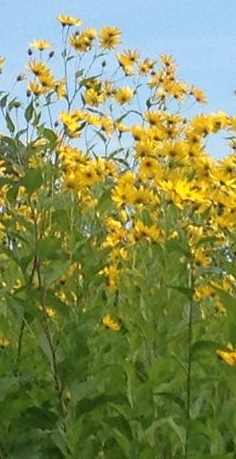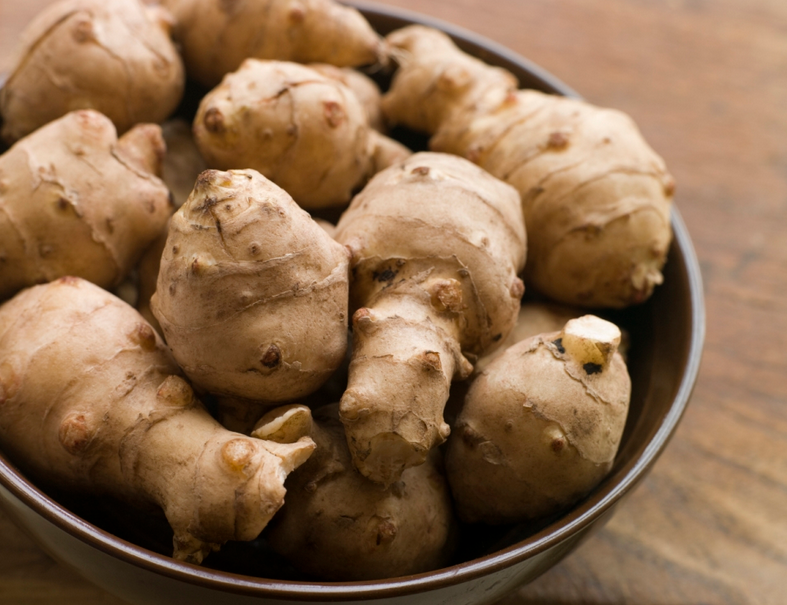Jerusalem Artichokes a.k.a. sunchokes or sunroot
Helianthus tuberosus
Jerusalem artichokes, also known as Sunchokes or Sunroot, is a native perennial tuber in the sunflower family. They produce tubers that are harvested in autumn through early spring, and will store for approximately 2 weeks in the refrigerator. Sunroots can be eaten raw, or roasted in the oven as a part of a tasty and healthy side dish.
Height: 6′ to 9′
Zones: 3 – 9
Days to Harvest: 120
Container: yes, large
Deer Resistant: normally
Plant Color: green
Bloom Color: yellow
Life Cycle: perennial
Spacing: 18″ to 2′
Juglone Tolerant: yes
Sunlight: full to partial
Soil: rich well drained, although tolerant of clay
Water: rainfall
Design Styles: potager garden edges, informal temporary privacy fence

History
In 1605 the Wampanoag introduced a root vegetable they called sunroot to the French explorer Samuel de Champlain. Its taste reminded him of artichokes, and he sent it to France.
When sunroot arrived in Italy, they were identified as girasole, or sunflower. A mispronunciation of its name by English speakers led to ‘Jerusalem’ artichoke.
Sunroot played an important role in hard times, notably during World War II in Europe. When potatoes were in short supply, sunroot tubers were used as a replacement for the vegetable.
Uses
These plants produce nutty flavored knobby tubers that have a crisp texture, similar to water chestnut.:
* raw
* boiled
* mashed
* baked
* stir-fry
* possible biofuel
* fast growing nature screen
Design
You can place this plant in the potager garden, yet be aware that the tubers need to be in an easily harvestable location. Sunchokes can also provide a quick growing privacy fence, and can be used as a temporary wind break if planted more closely together. Sunroot is tolerant to frost and poor soil.

Benefits
Sunchokes are low in calories, and can be stored for 2 weeks. Each plant can produce an abundance of tubers, and also very pretty yellow flowers in late summer into autumn.
Nutrition Information
Amount per 1 cup
Calories 100
Total Fat 1 g
Saturated fat 0 g
Cholesterol 0 mg
Sodium 0 mg
Potassium 0 mg
Total Carbohydrate: 27 g
Dietary fiber 10 g
Sugar 0 g
Protein 1 g
___________________________________
Vitamin A 0%
Vitamin C 87%
Vitamin B6 0%
Thiamin (B1) 0%
Vitamin E 0%
Niacin (B3) 0%
Riboflavin (B2) 0%
Folate 0%
* nutrient analysis by the University of
Hawaiʻi at Manoa
% Daily Value
0%
0%
0%
0%
0%
0%
0%
0%
___________________________________
Calcium 0%
Iron 0%
Magnesium 0%
Potassium 0%
Phosphorus 0%
Sodium 0%
Zinc 0%
Harvesting
Begin harvesting the tubers after the first frost, up until the ground freezes. Adding a thick layer of mulch before the frost can facilitate digging and extend harvest time into early spring. If grown in a vegetable garden or potager, completely remove the tubers at the end of harvest to prevent spreading.
To harvest Sunroot, cut off several stems at the base of the plant with loppers. Use a shovel to dig straight down, to lift a clump of tubers. The tubers look similar to pieces of ginger root. Tubers will easily come off the clump.
Rezenience Gardens and Design is mission-driven and specializes caring for people and planet.
We do this by providing the most healthful varieties of plants, fruits, and seeds, through
environmentally sound design services, and by means of education.
#PeopleAndPlanet
@Rezenience
